“Carnation, Lily, Lily, Rose” by John Singer Sargent – Floral Dream
“A wreath around her head, around her head she wore carnation lily, lily, rose”. This is a refrain from the song Ye Shepherds Tell Me! by Joseph Mazzinghi, and the inspiration behind the title of the painting Carnation, Lily, Lily, Rose by John Singer Sargent. Below, we will discuss the artwork in more detail!
Table of Contents
Artist Abstract: Who Was John Singer Sargent?
John Singer Sargent was born in Florence (Grand Duchy of Tuscany) on January 12, 1856. His date of death was April 14, 1925, in London, England. His parents were Americans who extensively traveled and lived in Europe. His artistic talents were encouraged from a young age and studied under Charles Auguste Émile Carolus-Duran in Paris.

He also passed the exams for the École des Beaux-Arts and received acclaim for his artistic talents. His art style ranged from genre paintings, and landscapes, to portraits in mediums like watercolor and oil paintings. Some of his artworks include El Jaleo (1882), Portrait of Madame X (1884), and Lady Agnew of Lochnaw (1892).
Carnation, Lily, Lily, Rose (c. 1885) by John Singer Sargent in Context
| Artist | John Singer Sargent (1856 – 1925) |
| Date Created | c. 1885 |
| Medium | Oil on canvas |
| Genre | Genre painting |
| Period/Movement | Impressionism |
| Dimensions (centimeters) | 174 x 153.7 |
| Series/Versions | N/A |
| Where Is It Housed? | Tate Britain, London, England |
| What It Is Worth | The Tate was encouraged by Sir Frederic Leighton, who was the president of the Royal Academy, to buy the painting and they acquired it from funding from the Chantrey Bequest in 1887. The price is uncertain. |
In the Carnation, Lily, Lily, Rose analysis below you will learn more about this oil on canvas by John Singer Sargent and some of the inspiration behind its origins. A formal analysis will describe the visual composition, which will include a brief overview of the primary art elements.
Contextual Analysis: A Brief Socio-Historical Overview
John Singer Sargent’s Carnation, Lily, Lily, Rose painting was painted at Farnham House in Broadway in the Cotswolds in England. He stayed with the Millet family, namely Francis Davis Millet, in 1885. He reportedly also stayed with Millet at their subsequent home, where they moved to in 1886, called the Russell House, also in Broadway. Millet’s homes were not any homes, they were also artist’s colonies and welcomed artists like John Singer Sargent, but also Edwin Austin Abbey, who was a painter and illustrator, the famous novelist Henry James, the writer, poet, and critic Edmund Gosse, and numerous others.
Sargent found his way to the Broadway colony when he moved from Paris to England, but let us quickly stopover in Paris, where Sargent’s full-length portrait painting, Madame X (1883 – 1884), caused quite a stir.
The portrait was thought to be of Virginie Gautreau, who had a reputation as a socialite. Sargent depicted her in a sensual manner with her dress revealing her neck and upper bust area, emphasizing her striking features. Sargent’s painting, Madame X, went on exhibition in 1884 at the Paris Salon. It reportedly received harsh criticism from reviewers and the public. Sargent also repainted what was initially a fallen shoulder strap to appear where it was socially acceptable, on Madame X’s shoulder.

The disappointment of Sargent’s Madame X portrait eventually caused the painter to move From Paris to London in 1885. England was where Sargent turned a page, so to say, in his artistry and painted among the artist’s colonies. While in England, Sargent traveled to places like Pangbourne on the River Thames in 1885, which is where he saw the Chinese lanterns and when inspiration struck. He also reportedly had a diving accident, which led him to visit the Millet’s home in Broadway where he recovered and created Carnation, Lily, Lily, Rose.
Sargent was known to have worked diligently on capturing the right light and would meet the twilight outside each evening to paint en-plein-air, the progress of which took two years, notably for two summers.
During this time Sargent decreased the size of his canvas, it had more of a square shape, and as has been described, gave him more focus to paint the scene; he reportedly “scraped” away what he painted every night due to his discontentment with the scene painted.
Formal Analysis: A Brief Compositional Overview
In the Carnation, Lily, Lily, Rose analysis you will read more about the painting itself and what the subject matter consists of. There will also be a discussion of the art elements and how they are utilized to create the composition.

Subject Matter: Visual Description
Carnation, Lily, Lily, Rose by John Singer Sargent depicts the two sisters, namely Dorothy and Polly Barnard, standing in a garden at what appears to be twilight. Dorothy is standing on the left, mostly in the center of the composition and slightly in a profile view, while her sister, Polly, is standing opposite her and on the right, slightly off-center and facing more towards us, the viewers. They are both engaged, looking down in concentration while lighting the Chinese lanterns in their hands.
Dorothy is holding a small round lantern in her left hand and lighting it with her right hand. Polly is holding a larger, more cylindrical shaped, lantern in her left hand, and lowering it downwards as she lifts her right hand to light it.
Both sisters have short, cropped hair and are wearing what appears to be identical long-sleeved white dresses that fall loosely below their knees with frills around the neckline and sleeves. Dorothy appears to be wearing black stockings and black shoes, and Polly’s legs are covered by the long grass around her but is possibly wearing the same.
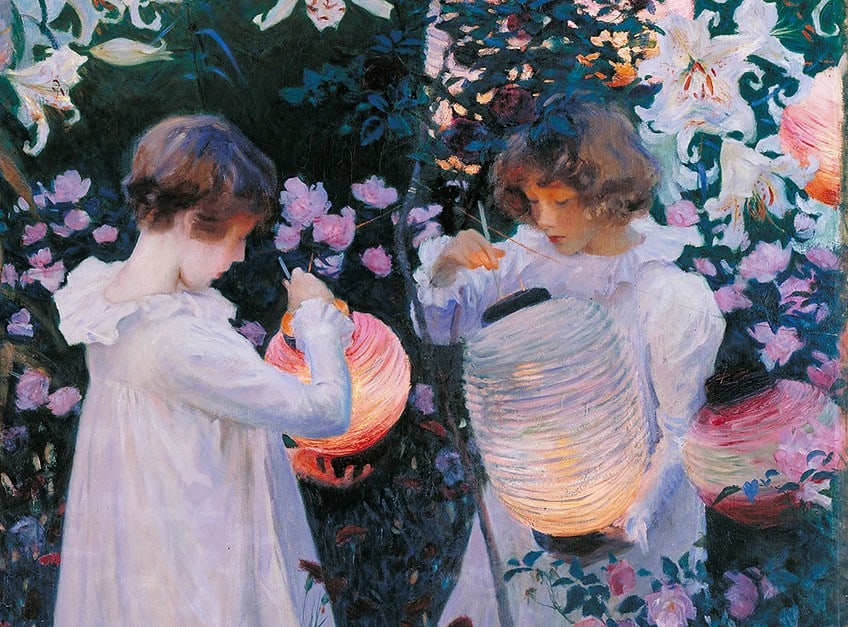
The scene is focused on the two girls, depicting mostly the greenery from the lush garden around them, which is filled with flowers and long green grass that seemingly envelops their feet and legs as they stand submerged in it. There are also several more lanterns, which are mostly lit except for one or two in the background.
Some of the flowers visible around the girls have been described as tall white lilies, which have been believed to be the Lilium Auratum, a Japanese lily, burgundy and light yellow-creamy colored carnations, and pink roses.
Color and Value
The colors in Carnation, Lily, Lily, Rose by John Singer Sargent are vibrant yet subdued to indicate the time of day, which is twilight. The onset of the night, which Sargent conveyed through the cooler shades of greens and blues. Pops of color appear in the flowers, for example, burgundy, light yellows, pinks, and more neutral whites for the girls’ dresses and the lanterns.
Warm reds, oranges, and peach-like colors compose the lit lanterns and imply a soft light inside of them, which further gives the outside setting a soft glow.
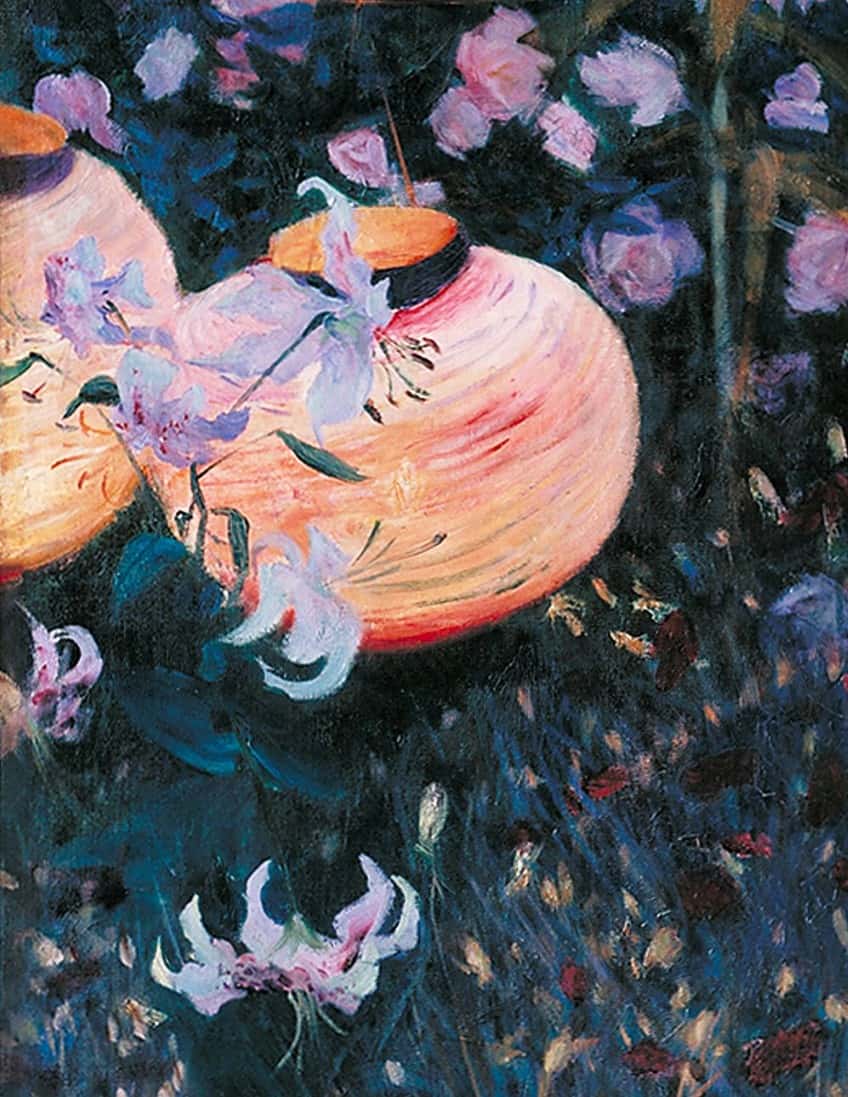
Texture
While there is a looseness and expressiveness about Sargent’s brushstrokes in Carnation, Lily, Lily, Rose, there is also implied texture through them, which provides a naturalistic effect to the subject matter. For example, the folds of the girls’ dresses, which appear soft and flowing, the flatter and smooth appearance of the blades of grass, and the thin and almost transparent appearance of the lanterns.
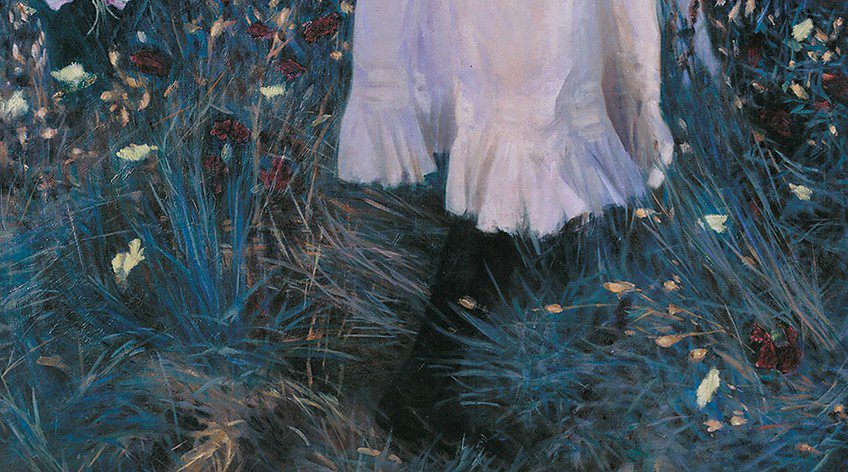
Line
There are a variety of lines in Carnation, Lily, Lily, Rose by John Singer Sargent, all of which create a realism to the composition. There are no contrasting outlines, which further adds to the naturalism.
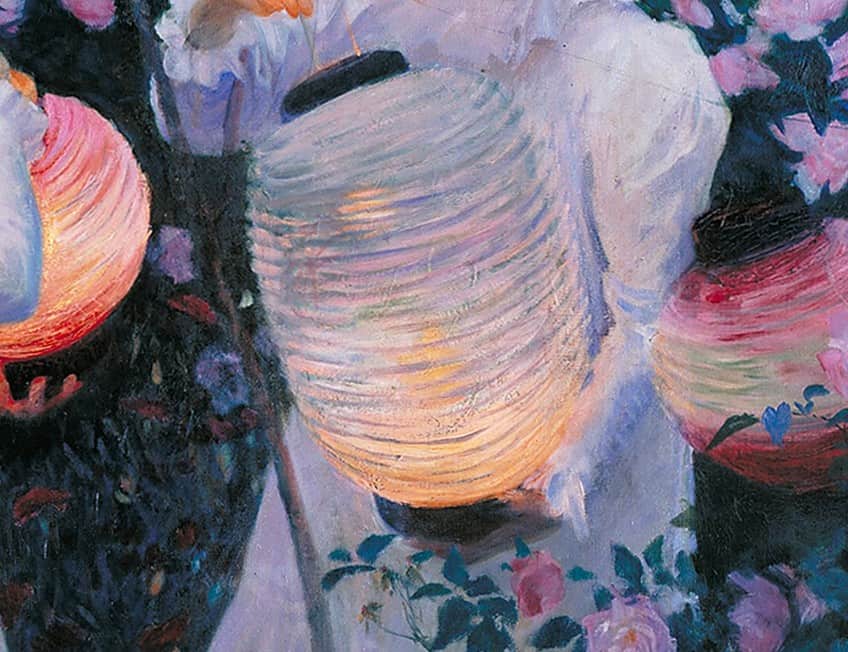
Shape and Form
There are naturalistic shapes and forms in Carnation, Lily, Lily, Rose by John Singer Sargent. For example, the fluid and irregular shapes of the foliage and flowers and figural forms of the two girls. There are some geometric shapes evident in the circular or bulbous and cylindrical shapes of the lanterns.

Space
The compositional space of Carnation, Lily, Lily, Rose by John Singer Sargent is focused on the two girls as they light their lanterns, and the viewpoint is level and slightly raised.
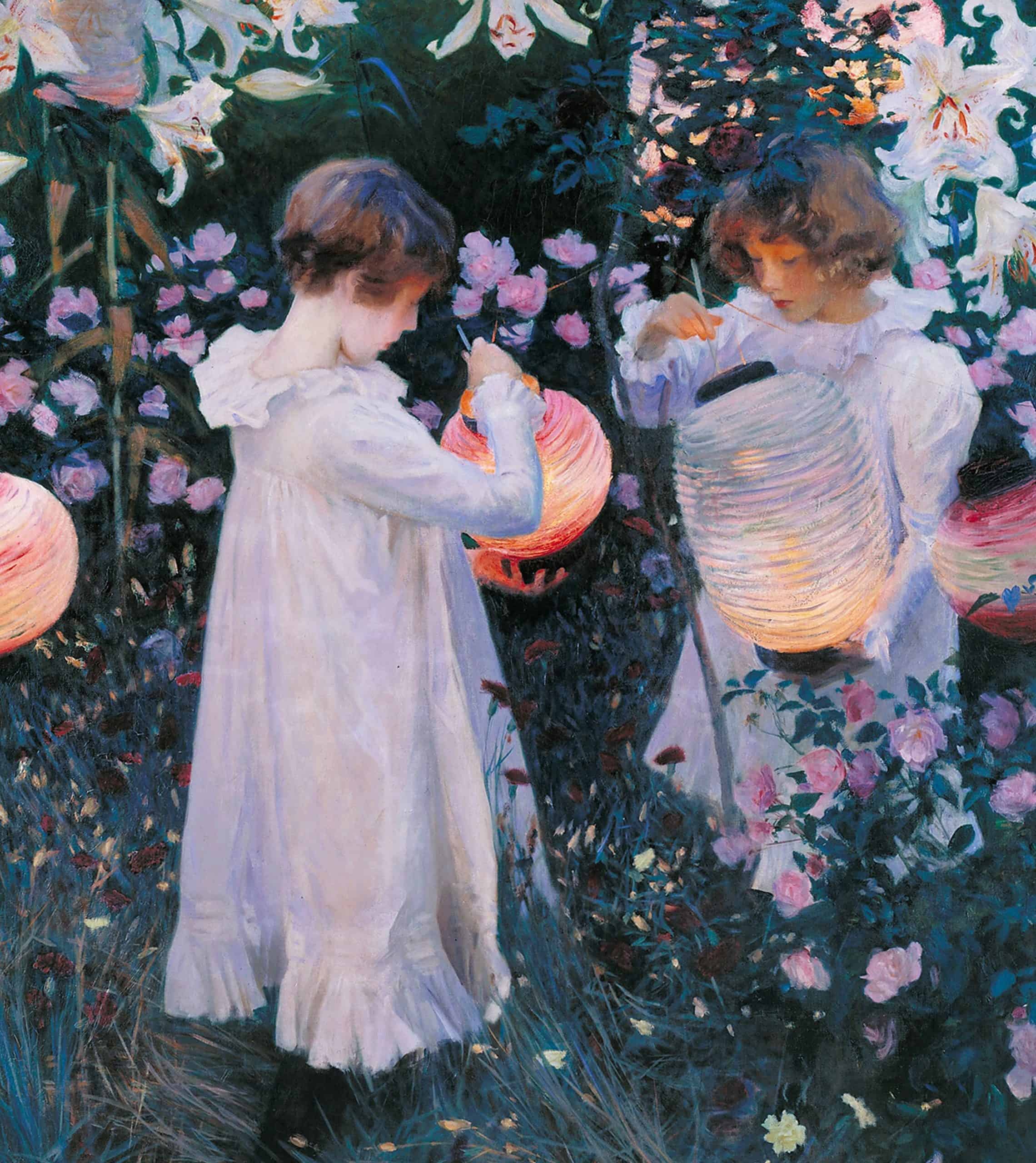
A Twilight Beauty
Carnation, Lily, Lily, Rose by John Singer Sargent was exhibited in 1887 at the summer exhibition of the Royal Academy in London. It received a combination of feedback, but it was believed to be a success after Sargent’s somewhat doubted exhibition of Madame X.
Reportedly Sir Frederic Leighton, the president of the Royal Academy, suggested that the Tate Britain purchase the painting, which the latter bought in 1887 from funding supplied through the Chantrey Bequest, however, the price is uncertain.
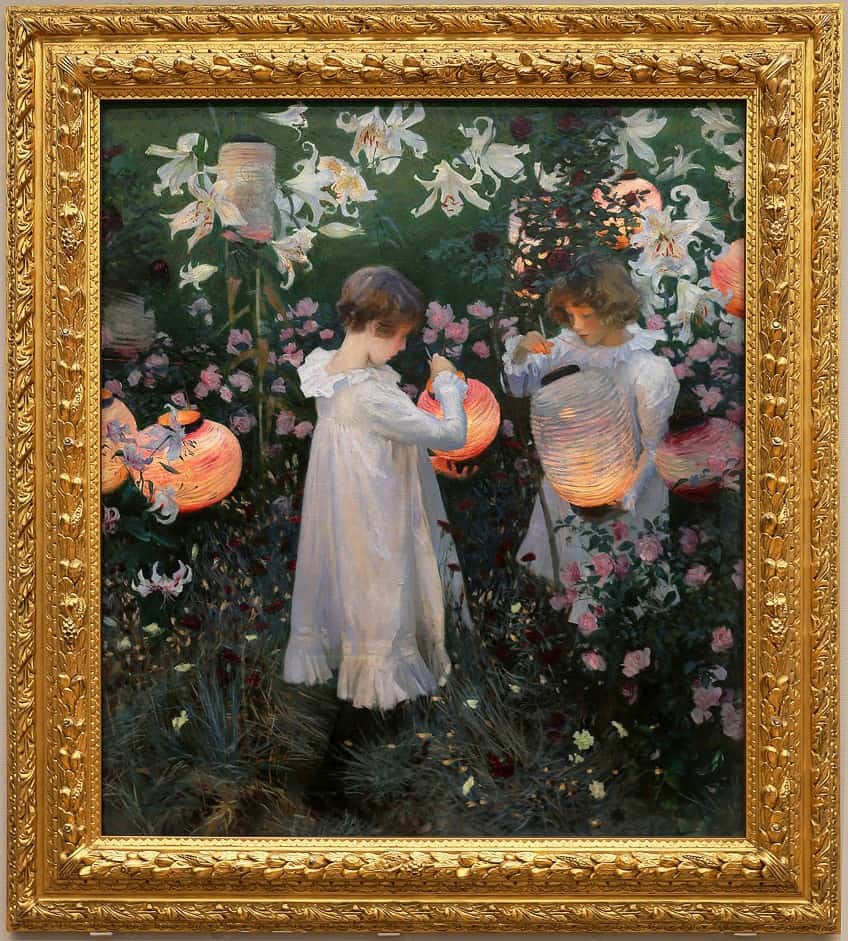
Carnation, Lily, Lily, Rose has often been described as depicting artistic qualities from Impressionism and the Aesthetic art styles. The outdoor scene hints at the characteristic Impressionistic en plein air approach, as it captures the changing light from day to night – a true twilight beauty.
Frequently Asked Questions
Who Created the Carnation, Lily, Lily, Rose Painting?
The American painter, John Singer Sargent, painted Carnation, Lily, Lily, Rose between 1885 and 1886. It is an oil on canvas and is housed at the Tate Britain in London, England.
Who Are the Girls Depicted in the Carnation, Lily, Lily, Rose Painting?
John Singer Sargent, who painted Carnation, Lily, Lily, Rose, utilized the Barnard sisters, namely, Dorothy (11 years old), who stands on the left, and Polly (seven years old), who stands on the right, as the models. Sargent originally started with Katherine Millet as the model.
What Inspired John Singer Sargent to Paint Carnation, Lily, Lily, Rose?
During September 1885, when John Singer Sargent stayed at Pangbourne on the River Thames, he saw Chinese lanterns that were amongst lilies and hanging on trees. He was so intrigued by the sight of these that he felt inspired to paint them.
Alicia du Plessis is a multidisciplinary writer. She completed her Bachelor of Arts degree, majoring in Art History and Classical Civilization, as well as two Honors, namely, in Art History and Education and Development, at the University of KwaZulu-Natal, South Africa. For her main Honors project in Art History, she explored perceptions of the San Bushmen’s identity and the concept of the “Other”. She has also looked at the use of photography in art and how it has been used to portray people’s lives.
Alicia’s other areas of interest in Art History include the process of writing about Art History and how to analyze paintings. Some of her favorite art movements include Impressionism and German Expressionism. She is yet to complete her Masters in Art History (she would like to do this abroad in Europe) having given it some time to first develop more professional experience with the interest to one day lecture it too.
Alicia has been working for artincontext.com since 2021 as an author and art history expert. She has specialized in painting analysis and is covering most of our painting analysis.
Learn more about Alicia du Plessis and the Art in Context Team.
Cite this Article
Alicia, du Plessis, ““Carnation, Lily, Lily, Rose” by John Singer Sargent – Floral Dream.” Art in Context. December 20, 2023. URL: https://artincontext.org/carnation-lily-lily-rose-by-john-singer-sargent/
du Plessis, A. (2023, 20 December). “Carnation, Lily, Lily, Rose” by John Singer Sargent – Floral Dream. Art in Context. https://artincontext.org/carnation-lily-lily-rose-by-john-singer-sargent/
du Plessis, Alicia. ““Carnation, Lily, Lily, Rose” by John Singer Sargent – Floral Dream.” Art in Context, December 20, 2023. https://artincontext.org/carnation-lily-lily-rose-by-john-singer-sargent/.











